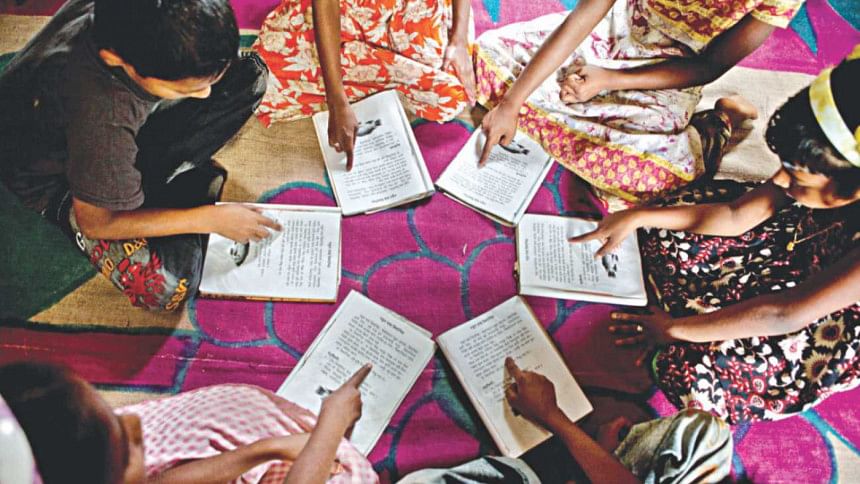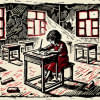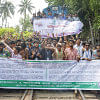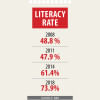Of what value is primary school completion?

Nearly all children now enrol in grade 1 and 80 percent are reaching grade 5, currently the final year of primary schooling. In the Primary Education Completion Exam (PECE), a mandatory national exam introduced in 2009, the latest pass rate is 98.5 percent. This is a success that cannot be ignored.
But can students who complete primary school read and do simple sums? A recent survey we conducted revealed that among children who had reached grade 5 (but not higher), 72 percent could read a grade 2 level story and only 40 percent could solve grade 2 level subtraction problems. In a large-scale national survey commissioned by the Directorate of Primary Education, only 25 percent of grade 5 students performed "at grade level" in Bangla and math.
PECE has led to a large increase in parents paying teachers to be tutors for children preparing for the exam. Many are concerned that tutors spend too much time making students memorise probable PECE questions, often using commercial guide books rather than helping students learn basic skills, and that grading of the PECE exam does not tell us what children really learn.
Seeking clues to this puzzle, we conducted a pilot survey in Nilphamari to measure student learning in reading and mathematics. We selected children who were in primary school or had completed grade 5 but did not go beyond. About 75 percent of the sampled children were attending or had attended a government primary school, about 20 percent an NGO school, and five percent a private school. The questions we asked on Bangla and math were simple, based on elements of the grade 2 Bangladesh government school curriculum.
We were inspired by the work of ASER, a non-profit learning survey organisation in India. Aser in Hindi means impact; the letters also stand for Annual Status of Education Report. Their premise is that children with primary education should be able to read, write and do basic sums—at least at the grade 2 level.
For the last decade, ASER has conducted surveys of primary school age children throughout rural India. Students are considered literate if they can read a short simple story with no more than three errors. They are considered numerate if they can solve two two-digit subtraction problems, requiring carryover.* What ASER found has generated a national public debate about the state of education in India. It has inspired a similar annual survey in Pakistan.
In our sample, 30 percent of children who reached up to grade 3 could read the story and 18 percent could solve the two subtraction problems. Children who had reached grade 5 did better, but more than a quarter could not read the grade 2 level story and 60 percent could not do the simple subtractions.
In ASER's 2016 survey, the comparable results across India were, in grade 3, 25 percent able to read the story and 28 percent able to do the subtractions. In grade 5, 48 percent could read the story and 51 percent could solve the two subtraction problems. Our sample students performed above the Indian average in reading, but below in arithmetic. Surely, these results are unacceptable for either country!
We draw two conclusions from the pilot. A simple survey should be part of a regular nationwide assessment of student learning and used as a measure for tracking change in primary education and making quality improvement decisions.
Second, PECE not only gives wrong signals about student outcomes, but also subverts the learning process. It should be discontinued. Genuine assessment of actual competency—an ASER approach as part of it—should be used.
The government and development partners are currently engaged in planning the next phase of the Primary Education Development Program. This is the perfect time to consider these ideas.
*We used the story in ASER's 2014 survey. It is of similar difficulty to grade 2 Bangla textbooks. Here is the translation:
"Tithi is the only daughter in the family. Dad and Mom love her very much. She likes to eat fish. Her father brings fish home every day. She then keeps hanging around her Mom. When the fish is fried in oil, she becomes very happy. Tithi eats three to four pieces of fish altogether. Father takes Tithi to the market. Some days father brings hilsha fish from the market. On those days, Tithi's happiness has no limits."
A typical subtraction problem required subtraction of 36 from 73.
John Richards is a professor at Simon Fraser University, Vancouver, Canada, who has been working on education and health issues in Bangladesh for over a decade. Shahidul Islam is USAID Bangladesh Education Team Leader. The views expressed are the authors' and not necessarily those of their respective organisations.










Comments